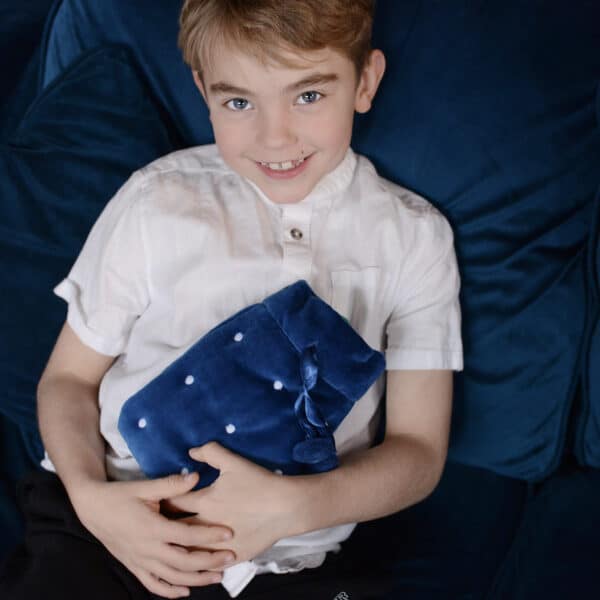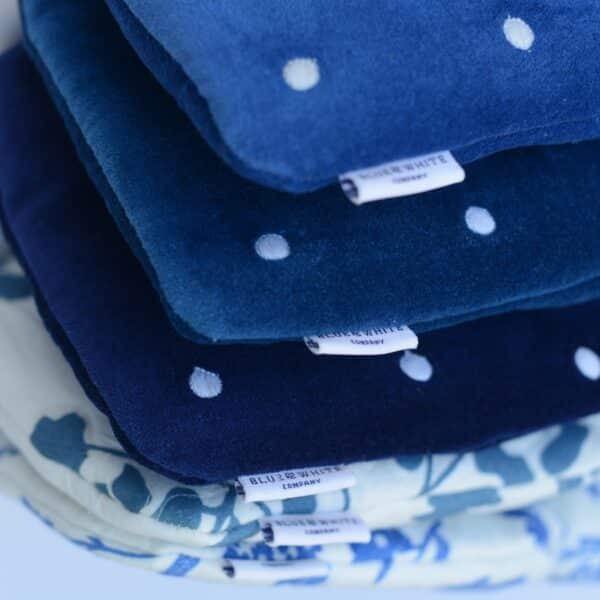Hot Water Bottles in Art History
Here at Blue & White Company, we are true believers that on a winter’s day there is nothing cosier than curling up with a cup of tea and a hot water bottle to combat the cold, or simply snuggling a hot water bottle and immersing yourself in a good book – whatever your age! We live a modern life of luxury with access to central heating and electric blankets so, if we appreciate this fabulous portable heat source, we can only imagine how much they must have been loved in times gone by. Or at least an older variation of a hot water bottle that it is.
Different Ways of Keeping Warm In Dutch Art
Throughout art history, especially in Dutch genre painting, it is possible to spot depictions of the different contraptions that kept our ancestors warm in the wintertime, although naturally not in the rubber form that we are so familiar with. Besides a traditional fireplace, there have been a variety of objects used to heat beds, feet, carriage interiors and so on over the centuries. Many of which would certainly be considered as objects of the decorative arts.
Today we thought we would have a look at a brief timeline, as seen in Dutch art, of the ways people used to keep warm before the development of the modern day hottie!
The Art of Heating Pans
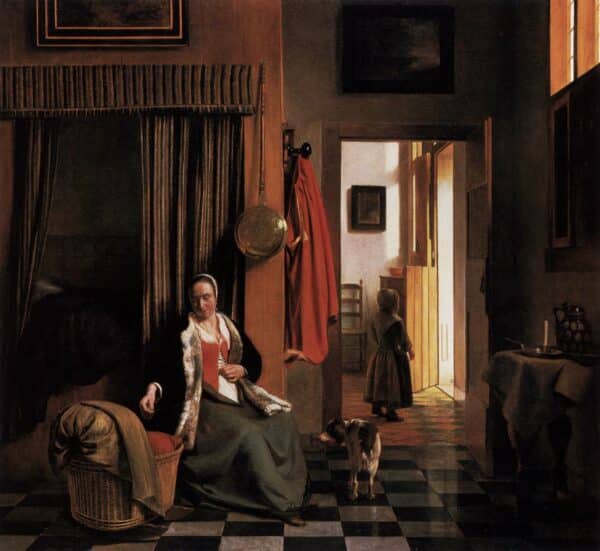
Pieter de Hooch, Mother Lacing Her Bodice Beside a Cradle, c.1660-1663, Oil on Canvas
Whilst it is believed that different types of heating instruments have been used for many hundreds of years, from the 17th century the motif of the brass/bronze heating pan began to reoccur in art.
They are especially noticeable in 1600s Dutch interior paintings, as seen above in Pieter de Hooche’s Mother Lacing Her Bodice beside a Cradle. The frequency of this particular imagery is no doubt indicative of the heating pan’s rise in popularity as a device to warm beds in the long, cold European and North American winters.
In the same way we would use our modern hottie, a heating pan would be placed between the sheets of a bed, but having been filled with hot coals or embers from the fire. Unlike our modern hottie, this would require a certain amount of skill to avoid burns or even flames!
Functional Yet Beautiful
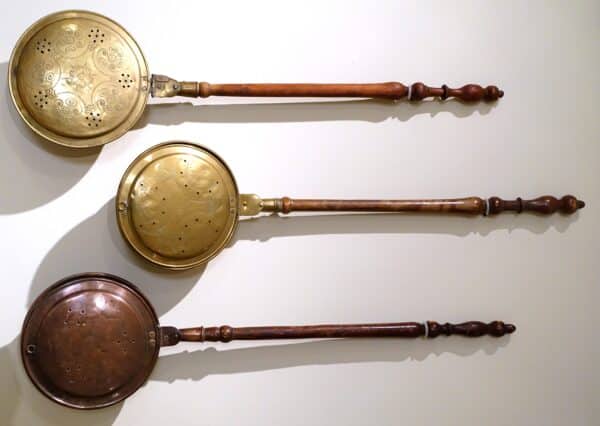
Brass Heating Pans
Although one might consider the innovative design of the heating pans art in itself, more often than not the surface of a warming pan would be decorated with an elegant or intricate pattern. If you were to visit the V&A in London, for example, you would be able to view the beautifully crafted 1602 brass pan, on which Venus and Cupid are surrounded by foliage and encircled by a humorous inscription (more on that later). This imagery is a perfect example of an elaborate design that can be found adorning many of the heating pans from this time.
When considering the decorative aspect of these heating instruments, we can see an interesting parallel between the 1600s and the modern day. This being the way we retain the desire to own and display aesthetically pleasing functional objects. Even those destined to be hidden between sheets, strategically placed under jumpers or tucked into pockets.
Combining beauty and functionality is one of life’s simple pleasures and it’s the reason we included embroidery on our new hot water bottle collection as well, to meet this core aesthetic pleasure.
The Many Meanings of a Foot Stove’s Heat
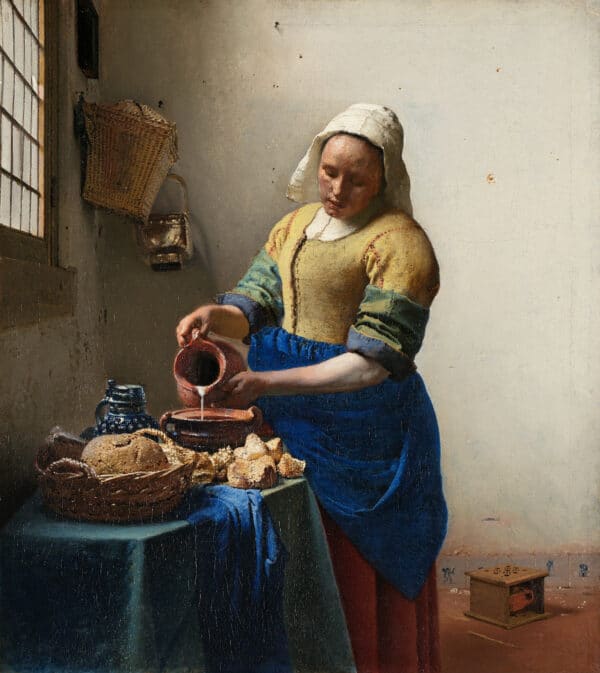
Johannes Vermeer, The Milkmaid, C. 1660, OIl on Canvas
Another object that was an immensely popular form of portable heating, whilst also considered to be decorative, was the wooden foot stove/foot warmer. Similar in concept to the heating pan, the wooden foot warmers held hot coals from the fire. The perforations in the stove’s sides and surface allowed the heat to escape whilst their box shape made them a perfect rest for an elegant lady’s foot. Like heating pans, foot stoves were a popular means of mobile domestic heating, however their portability also made them excellent for other settings such as carriages, sleighs and trains.
Also like the heating pan, the foot stove regularly appears in 17th-18th century Dutch interiors. Symbolism and motif was a huge part of Dutch Baroque genre painting and the imagery of the foot stove serves its individual purpose. Often included in pieces where the stove was by no means the main focus of the composition, the miniature heater implied not only the artist’s attention to detail, their ability to paint skillfully, the advanced living standards of the Dutch Golden Age but also a slightly more euphemistic notion.
Cupid and Keeping Warm in Dutch Art
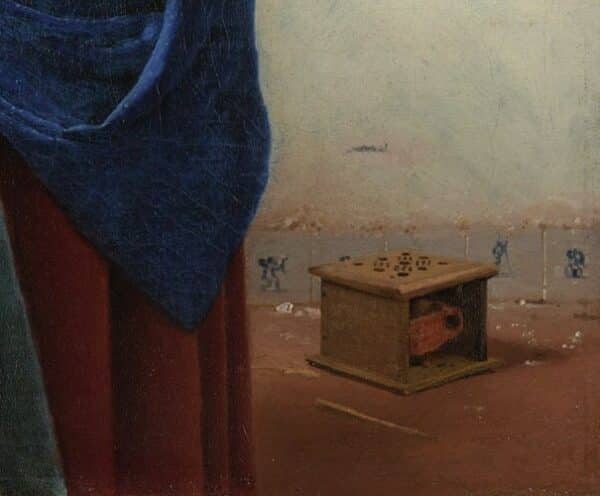
Detail of Cupid and the Foot Stove in The Milkmaid by Johannes Vermeer
As we touched on earlier, almost everything in Dutch genre painting had some sort of iconographical meaning. The foot stove being no exception. In fact, the humble foot warmer was somewhat explicit in its evocation. It actually insinuated the heat of lust, as it was most frequently found beneath a lady’s skirt raising the temperature of the lower regions!
A fantastic example of this motif can be seen in Vermeer’s The Milkmaid. In which we are treated to some wonderfully subtle symbolism in the form of a miniature depiction of Cupid painted in blue (a lovely parallel to the rich blue skirts and table cloth in the left of the composition). In what is believed to be an act of strategic genius, Vermeer has placed the miniature love god and his arrows of desire to the left of the foot warmer. This placement is thought to emphasise the stove as an emblem of the milkmaid’s sexual availability.
This links us back to the beautiful, brass heating pan currently housed in the V&A. Here we also see the image of Cupid, no doubt also in reference to the heat of passion. Not only does Cupid’s presence imply such lust, but the amusing Dutch inscription around the outside reads:
“This pan is suited for women who like to sleep in a warm bed and who have nobody to warm them, so they have to fire their bed by means of a pan if they haven’t got a man who can warm their feet for them”
A tongue in cheek suggestion, perhaps, of the 17th century Dutch view on the more ‘fragile’ condition of women and their desire to be warm and cared for. Clearly a quote of its time – here at B&W HQ we can’t help but think if the ladies in question had had the opportunity to own one of our gorgeous new hot water bottles, they would have been even more content!
After all, what could be more fitting than a Old Delft Blue Velvet hottie to enhance a charming Dutch interior. Or any interior as it happens!
Hot Water Bottles of the Modern Day
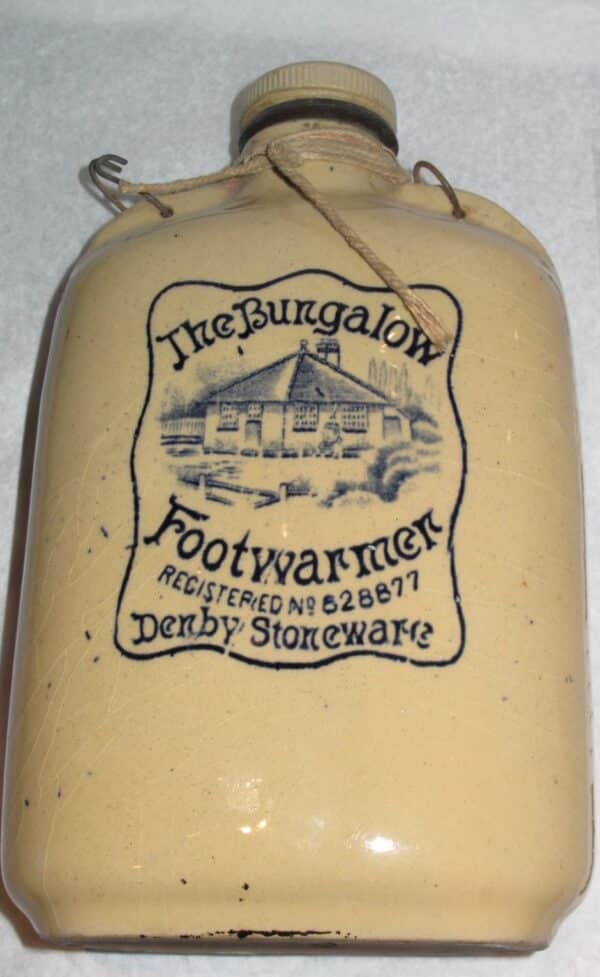
Ceramic Denby Hot Water Bottle, Attribution: Auckland Museum
Finally, as we reach the late 1800s, a shift from heating pans and foot stoves (each with their own fire and burn hazards) was being made in ceramic or earthenware containers. Stoppered by stone or cork, filled with hot water and wrapped in a blanket material for added comfort and less risk of being scalded, these were the penultimate evolution in heating instruments before the flexible hottie came to be.
In order to achieve the hot water bottle we are so familiar with, however, there was a key development that came about in the 19th century. In 1839, Charles Goodyear refined the process of vulcanising rubber. This meant the rubber hottie we know and love today was steadily developed and, by the early 1900s, was available to keep you toasty at a much lower risk to you, your sheets or feet!
Here at Blue & White Company our affinity for a hot water bottle in every season is absolute, given their capacity to soothe and comfort, and provide gentle sleep support. The subtlety of a mini hot water bottle combines with a practical and more measured source of heat than larger hotties, whilst fitting in your bag as the ideal travel companion; our photographer’s children also show how loved they are for sleepovers!
Whether you prefer a delicate cotton floral pattern with beautiful stitching or a soft velvet embroidered fabric, our collection of hotties come in a selection of blues and will be sure to bring you warmth and joy through both their function and design.
